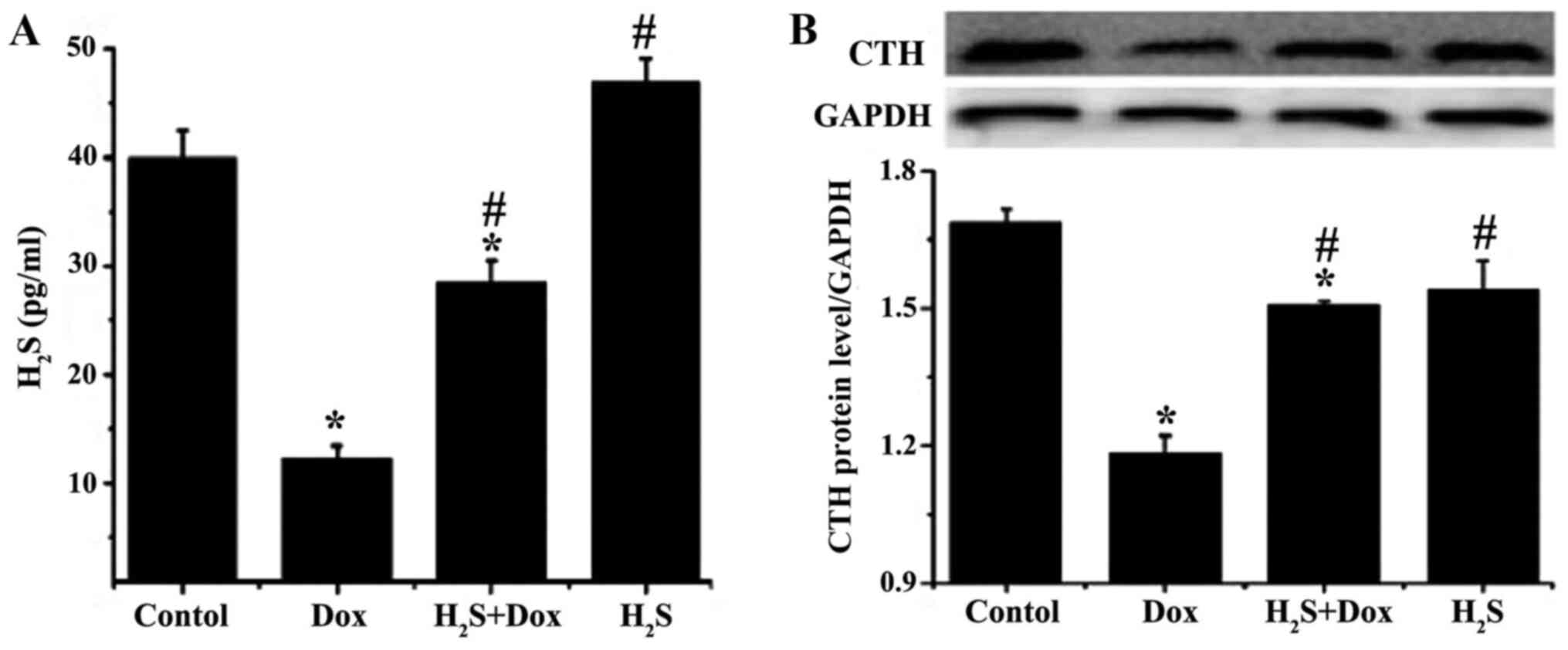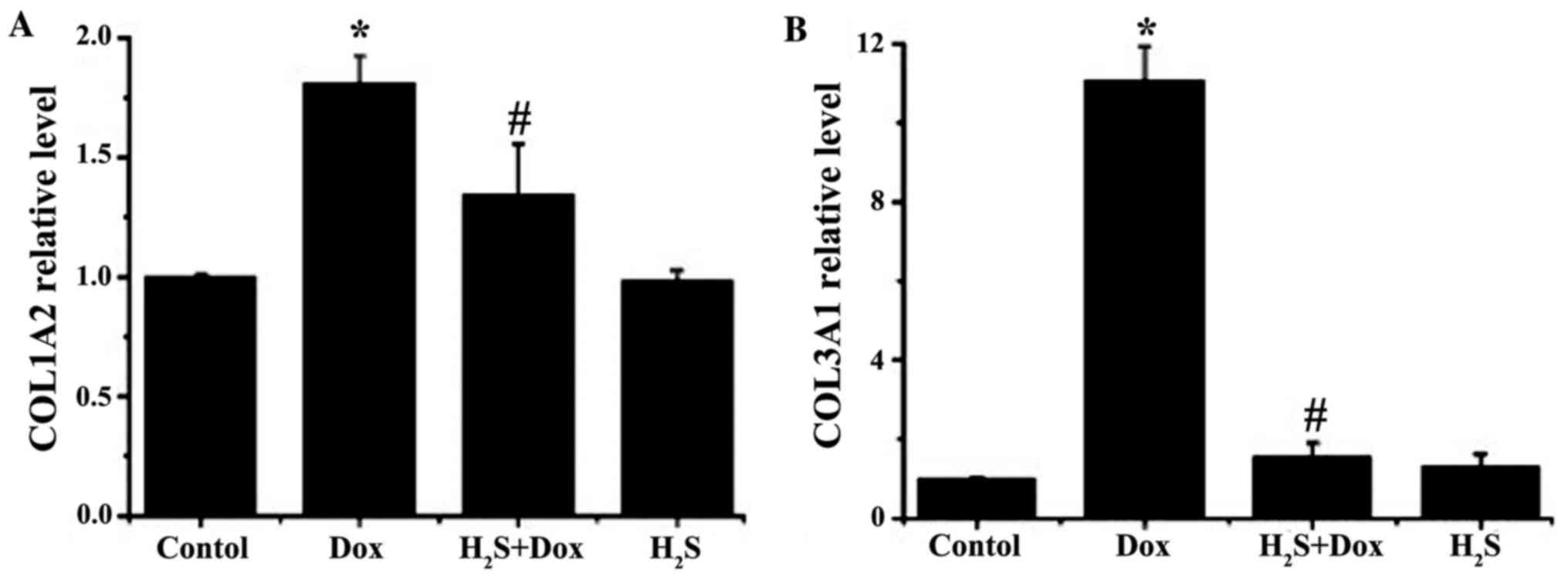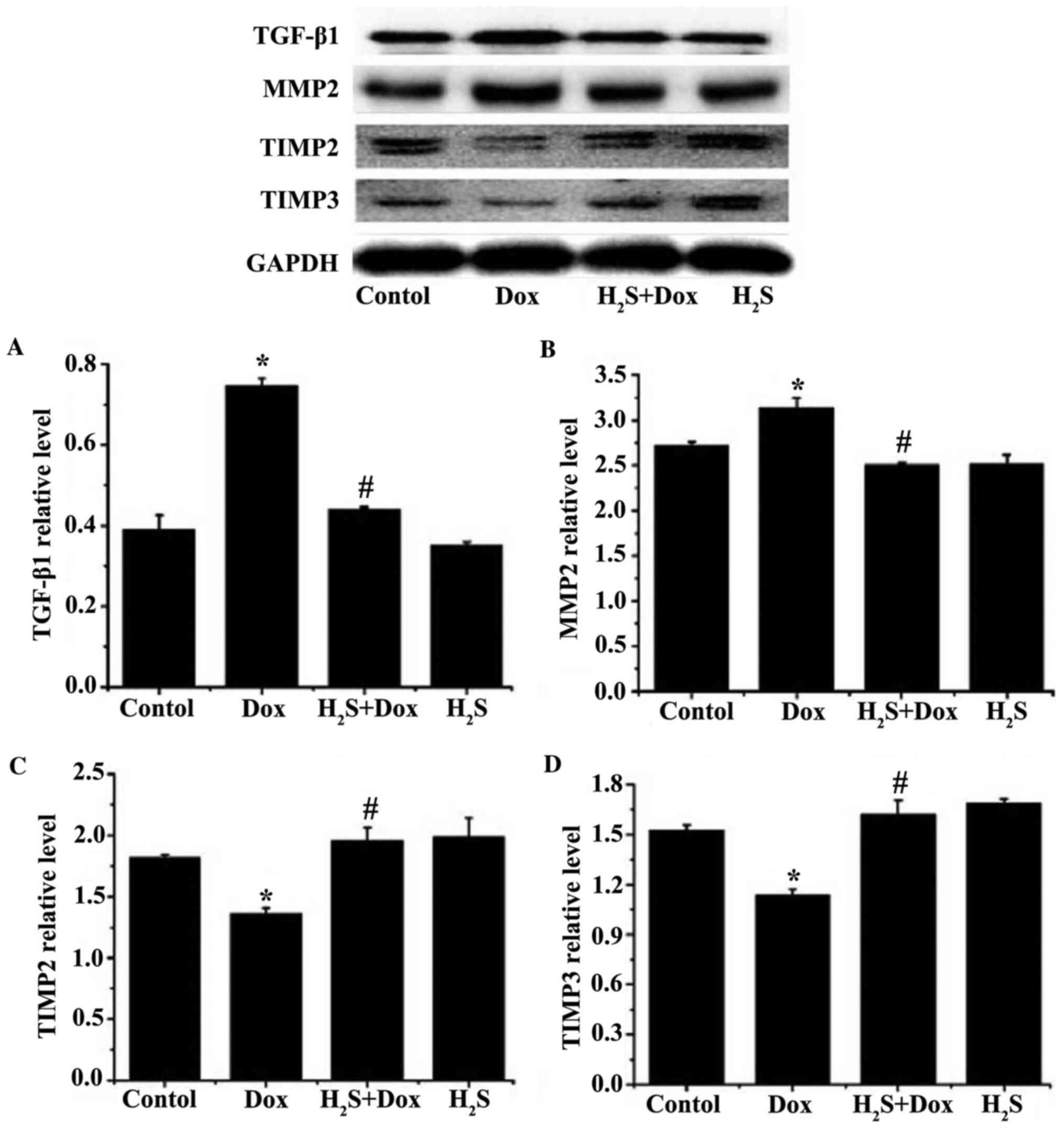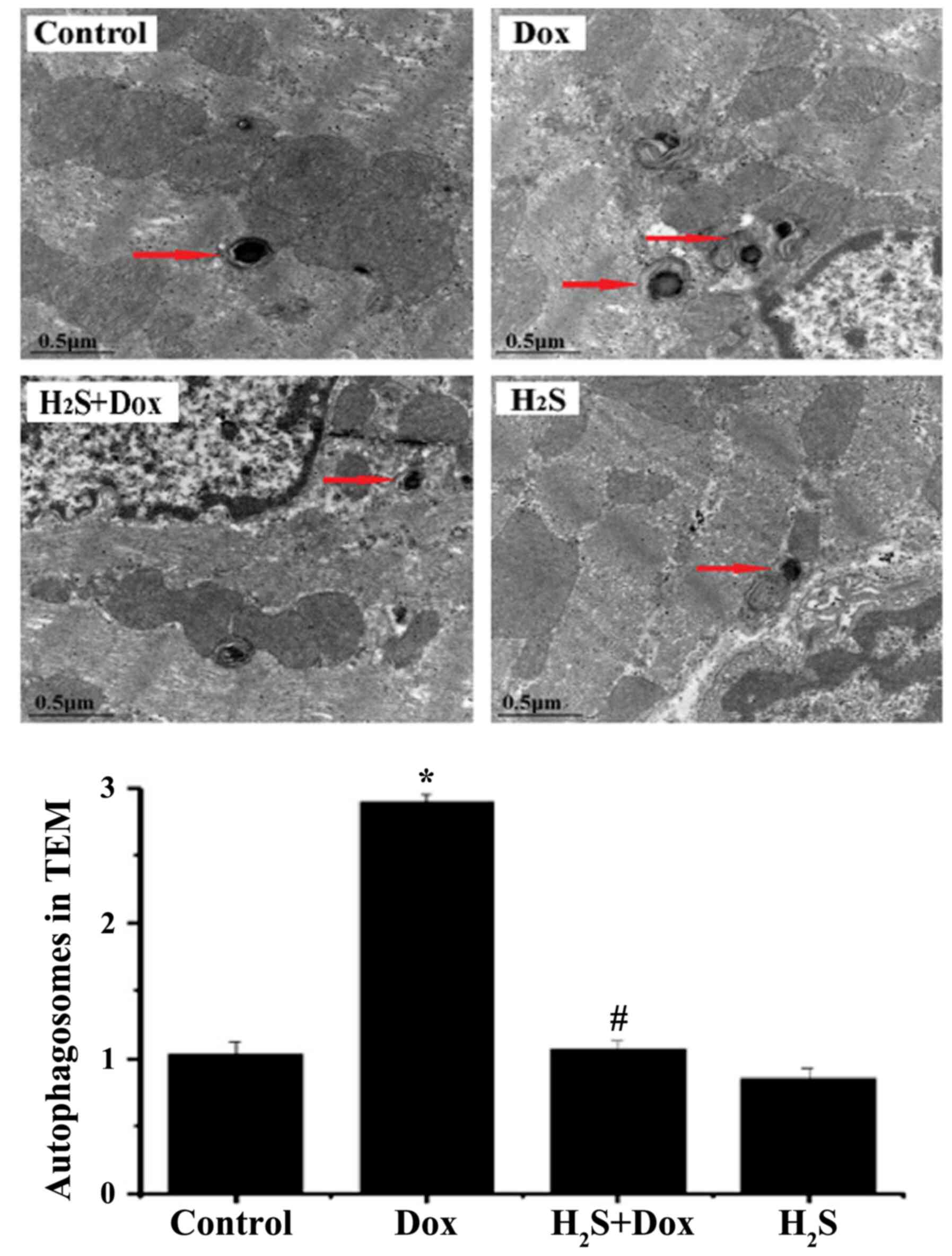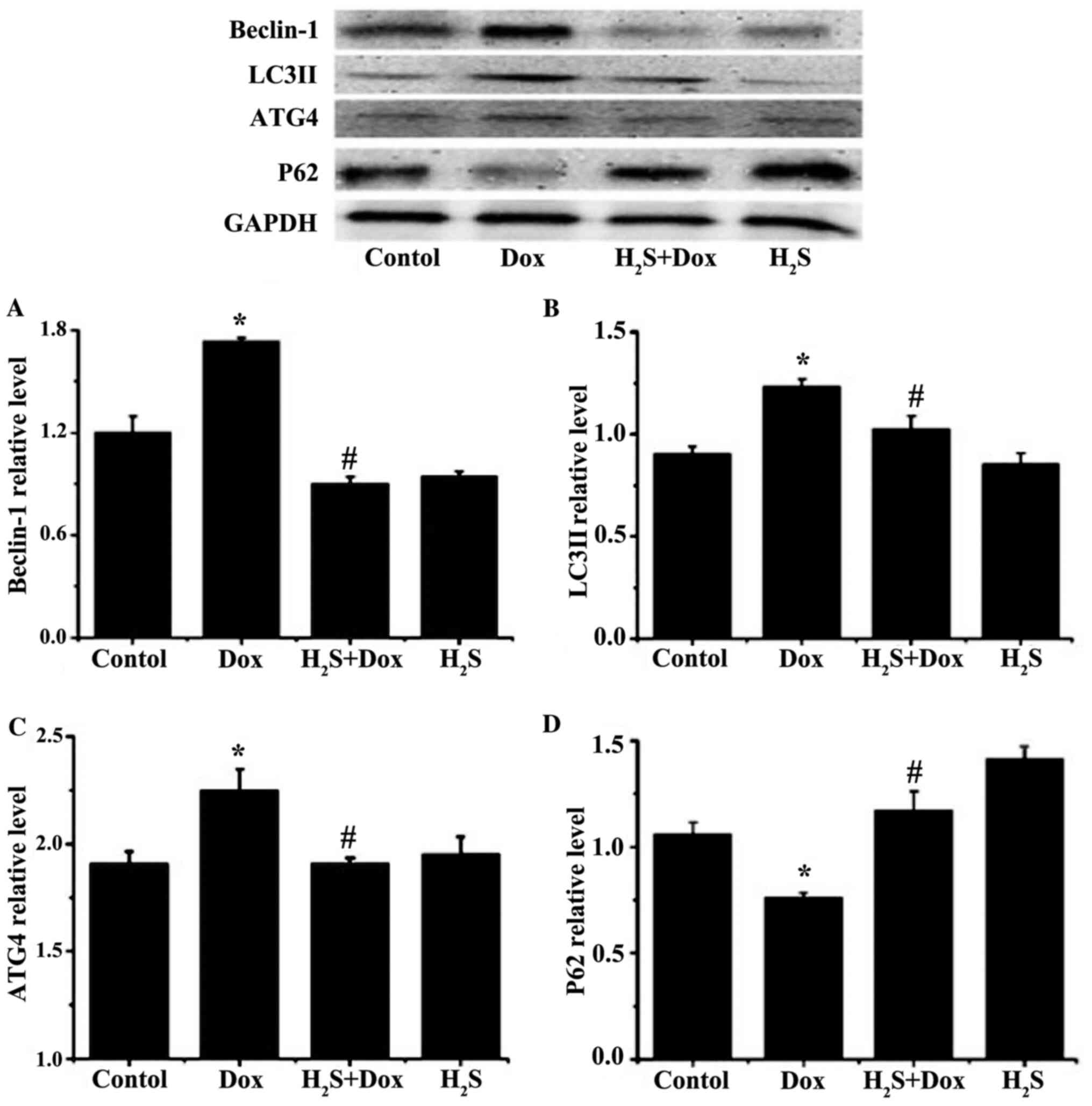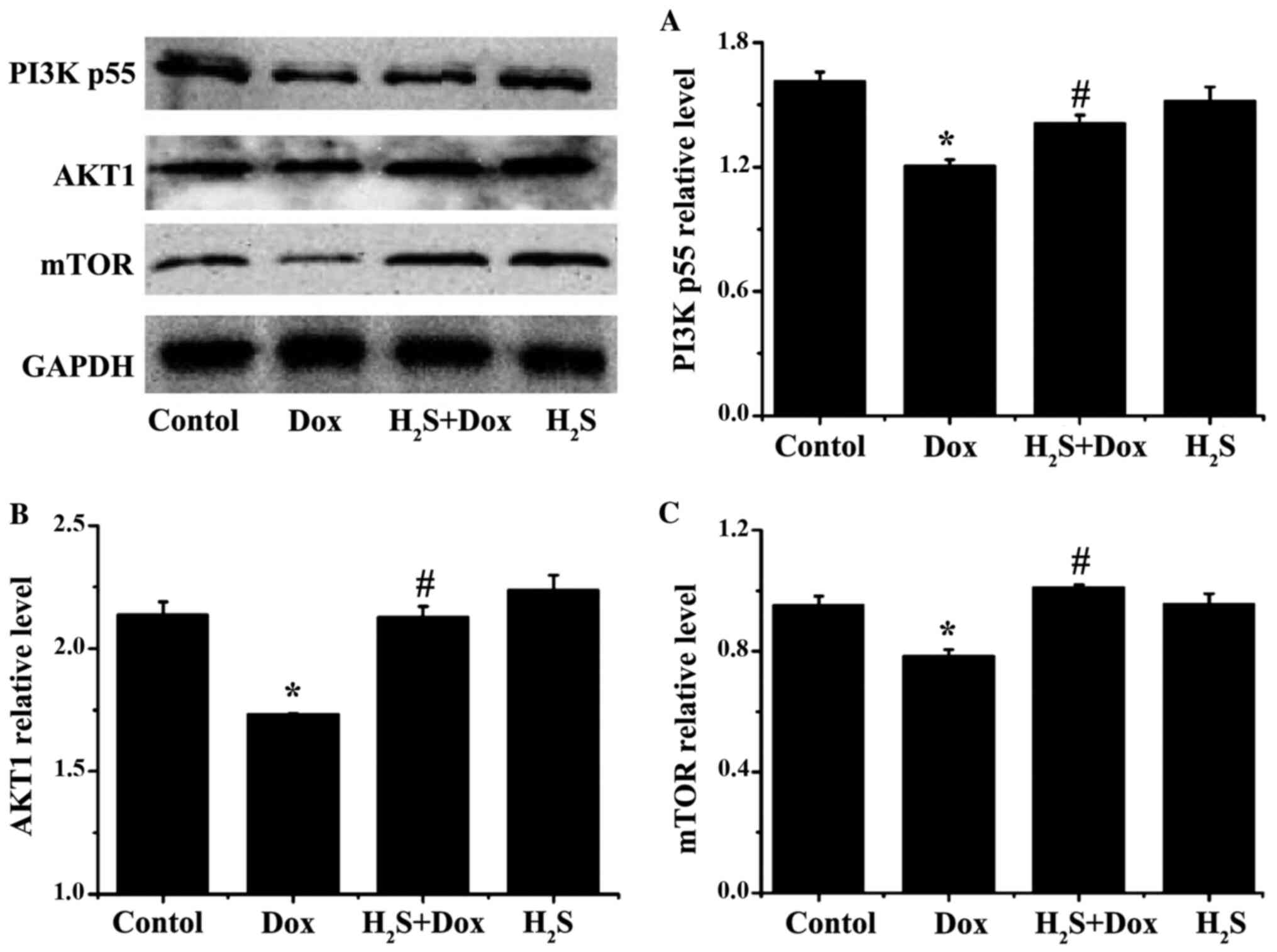|
1
|
Jefferies JL and Towbin JA: Dilated
cardiomyopathy. Lancet. 375:752–762. 2010. View Article : Google Scholar : PubMed/NCBI
|
|
2
|
Geng C, Cui C, Wang C, Lu S, Zhang M, Chen
D and Jiang P: Systematic evaluations of doxorubicin-induced
toxicity in rats based on metabolomics. ACS Omega. 6:358–366. 2021.
View Article : Google Scholar : PubMed/NCBI
|
|
3
|
Xia Y, Chen Z, Chen A, Fu M, Dong Z, Hu K,
Yang X, Zou Y, Sun A, Qian J and Ge J: LCZ696 improves cardiac
function via alleviating Drp1-mediated mitochondrial dysfunction in
mice with doxorubicin-induced dilated cardiomyopathy. J Mol Cell
Cardiol. 108:138–148. 2017. View Article : Google Scholar : PubMed/NCBI
|
|
4
|
Yao YF, Liu X, Li WJ, Shi ZW, Yan YX, Wang
LF, Chen M and Xie MY: (−)-Epigallocatechin-3-gallate alleviates
doxorubicin-induced cardiotoxicity in sarcoma 180 tumor-bearing
mice. Life Sci. 180:151–159. 2017. View Article : Google Scholar : PubMed/NCBI
|
|
5
|
Wang X, Li C, Wang Q, Li W, Guo D, Zhang
X, Shao M, Chen X, Ma L, Zhang Q, et al: Tanshinone IIA restores
dynamic balance of autophagosome/autolysosome in
doxorubicin-induced cardiotoxicity via targeting beclin1/LAMP1.
Cancers (Basel). 11:9102019. View Article : Google Scholar
|
|
6
|
Hasinoff BB, Patel D and Wu X: A QSAR
study that compares the ability of bisdioxopiperazine analogs of
the doxorubicin cardioprotective agent dexrazoxane (ICRF-187) to
protect myocytes with DNA topoisomerase II inhibition. Toxicol Appl
Pharmacol. 399:1150382020. View Article : Google Scholar : PubMed/NCBI
|
|
7
|
Gava FN, Zacché E, Ortiz EMG, Champion T,
Bandarra MB, Vasconcelos RO, Barbosa JC and Camacho AA: Doxorubicin
induced dilated cardiomyopathy in a rabbit model: An update. Res
Vet Sci. 94:115–121. 2013. View Article : Google Scholar : PubMed/NCBI
|
|
8
|
Yu Q, Li Q, Na R, Li X, Liu B, Meng L,
Liutong H, Fang W, Zhu N and Zheng X: Impact of repeated
intravenous bone marrow mesenchymal stem cells infusion on
myocardial collagen network remodeling in a rat model of
doxorubicin-induced dilated cardiomyopathy. Mol Cell Biochem.
387:279–285. 2014. View Article : Google Scholar : PubMed/NCBI
|
|
9
|
Wu X, Qi X, Lu Y, Lin C, Yuan Y, Zhu Q,
Yin Q, Li W, Li Y and Bian H: Liguzinediol protects against cardiac
fibrosis in rats in vivo and in vitro. Biomed Pharmacother.
80:260–267. 2016. View Article : Google Scholar : PubMed/NCBI
|
|
10
|
Liu S, Chen S, Li M, Zhang B, Shen P, Liu
P, Zheng D, Chen Y and Jiang J: Autophagy activation attenuates
angiotensin II-induced cardiac fibrosis. Arch Biochem Biophys.
590:37–47. 2016. View Article : Google Scholar : PubMed/NCBI
|
|
11
|
Li SJ, Liu CH, Chu HP, Mersmann HJ, Ding
ST, Chu CH, Wang CY and Chen CY: The high-fat diet induces
myocardial fibrosis in the metabolically healthy obese minipigs-The
role of ER stress and oxidative stress. Clin Nutr. 36:760–767.
2017. View Article : Google Scholar : PubMed/NCBI
|
|
12
|
Zeglinski MR, Davies JJL, Ghavami S,
Rattan SG, Halayko AJ and Dixon IMC: Chronic expression of Ski
induces apoptosis and represses autophagy in cardiac
myofibroblasts. Biochim Biophys Acta. 1863:1261–1268. 2016.
View Article : Google Scholar : PubMed/NCBI
|
|
13
|
González A, López B, Ravassa S, San José G
and Díez J: The complex dynamics of myocardial interstitial
fibrosis in heart failure. Focus on collagen cross-linking. Biochim
Biophys Acta Mol Cell Res. 1866:1421–1432. 2019. View Article : Google Scholar : PubMed/NCBI
|
|
14
|
Yang R, Jia Q, Ma SF, Wang Y, Mehmood S
and Chen Y: Exogenous H2S mitigates myocardial fibrosis in diabetic
rats through suppression of the canonical Wnt pathway. Int J Mol
Med. 44:549–558. 2019.PubMed/NCBI
|
|
15
|
Song H and Ren J: Protocatechuic acid
attenuates angiotensin II-induced cardiac fibrosis in cardiac
fibroblasts through inhibiting the NOX4/ROS/p38 signaling pathway.
Phytother Res. 33:2440–2447. 2019. View Article : Google Scholar : PubMed/NCBI
|
|
16
|
Russo I, Cavalera M, Huang S, Su Y, Hanna
A, Chen B, Shinde AV, Conway SJ, Graff J and Frangogiannis NG:
Protective effects of activated myofibroblasts in the
pressure-overloaded myocardium are mediated through smad-dependent
activation of a matrix-preserving program. Circ Res. 124:1214–1227.
2019. View Article : Google Scholar : PubMed/NCBI
|
|
17
|
Xiao T, Zeng O, Luo J, Wu Z, Li F and Yang
J: Effects of hydrogen sulfide on myocardial fibrosis in diabetic
rats: Changes in matrix metalloproteinases parameters. Biomed Mater
Eng. 26 (Suppl 1):S2033–S2039. 2015.PubMed/NCBI
|
|
18
|
Liu M, Li Z, Liang B, Li L, Liu S, Tan W,
Long J, Tang F, Chu C and Yang J: Hydrogen sulfide ameliorates rat
myocardial fibrosis induced by thyroxine through PI3K/AKT signaling
pathway. Endocr J. 65:769–781. 2018. View Article : Google Scholar : PubMed/NCBI
|
|
19
|
Liang B, Xiao T, Long J, Liu M, Li Z, Liu
S and Yang J: Hydrogen sulfide alleviates myocardial fibrosis in
mice with alcoholic cardiomyopathy by downregulating autophagy. Int
J Mol Med. 40:1781–1791. 2017.PubMed/NCBI
|
|
20
|
Miricescu D, Totan A, Stanescu-Spinu II,
Badoiu SC, Stefani C and Greabu M: PI3K/AKT/mTOR signaling pathway
in breast cancer: From molecular landscape to clinical aspects. Int
J Mol Sci. 22:1732020. View Article : Google Scholar
|
|
21
|
Zhang N, Zhang J, Tan YQ, Du GF, Lu R and
Zhou G: Activated Akt/mTOR-autophagy in local T cells of oral
lichen planus. Int Immunopharmacol. 48:84–90. 2017. View Article : Google Scholar : PubMed/NCBI
|
|
22
|
Heras-Sandoval D, Pérez-Rojas JM,
Hernández-Damián J and Pedraza-Chaverri J: The role of
PI3K/AKT/mTOR pathway in the modulation of autophagy and the
clearance of protein aggregates in neurodegeneration. Cell Signal.
26:2694–2701. 2014. View Article : Google Scholar : PubMed/NCBI
|
|
23
|
Thellung S, Corsaro A, Nizzari M, Barbieri
F and Florio T: Autophagy activator drugs: A new opportunity in
neuroprotection from misfolded protein toxicity. Int J Mol Sci.
20:9012019. View Article : Google Scholar
|
|
24
|
Rashid HO, Yadav RK, Kim HR and Chae HJ:
ER stress: Autophagy induction, inhibition and selection.
Autophagy. 11:1956–1977. 2015. View Article : Google Scholar : PubMed/NCBI
|
|
25
|
Huang TJ, Ren JJ, Zhang QQ, Kong YY, Zhang
HY, Guo XH, Fan HQ and Liu LX: IGFBPrP1 accelerates autophagy and
activation of hepatic stellate cells via mutual regulation between
H19 and PI3K/AKT/mTOR pathway. Biomed Pharmacother. 116:1090342019.
View Article : Google Scholar : PubMed/NCBI
|
|
26
|
Kim CS, Kim IJ, Choi JS, Bae EH, Ma SK and
Kim SW: Tamoxifen ameliorates obstructive nephropathy through Src
and the PI3K/Akt/mTOR pathway. Biol Cell. 111:18–27. 2019.
View Article : Google Scholar : PubMed/NCBI
|
|
27
|
Szabo C: Hydrogen sulfide, an endogenous
stimulator of mitochondrial function in cancer cells. Cells.
10:2202021. View Article : Google Scholar : PubMed/NCBI
|
|
28
|
Polyakova V, Loeffler I, Hein S, Miyagawa
S, Piotrowska I, Dammer S, Risteli J, Schaper J and Kostin S:
Fibrosis in endstage human heart failure: Severe changes in
collagen metabolism and MMP/TIMP profiles. Int J Cardiol.
151:18–33. 2011. View Article : Google Scholar : PubMed/NCBI
|
|
29
|
El Hajj EC, El Hajj MC, Voloshenyuk TG,
Mouton AJ, Khoutorova E, Molina PE, Gilpin NW and Gardner JD:
Alcohol modulation of cardiac matrix metalloproteinases (MMPs) and
tissue inhibitors of MMPs favors collagen accumulation. Alcohol
Clin Exp Res. 38:448–456. 2014. View Article : Google Scholar : PubMed/NCBI
|
|
30
|
Wu WY, Cui YK, Hong YX, Li YD, Wu Y, Li G,
Li GR and Wang Y: Doxorubicin cardiomyopathy is ameliorated by
acacetin via Sirt1-mediated activation of AMPK/Nrf2 signal
molecules. J Cell Mol Med. 24:12141–12153. 2020. View Article : Google Scholar : PubMed/NCBI
|
|
31
|
Chen C, Jiang L, Zhang M, Pan X, Peng C,
Huang W and Jiang Q: Isodunnianol alleviates doxorubicin-induced
myocardial injury by activating protective autophagy. Food Funct.
10:2651–2657. 2019. View Article : Google Scholar : PubMed/NCBI
|
|
32
|
Fu HY, Sanada S, Matsuzaki T, Liao Y,
Okuda K, Yamato M, Tsuchida S, Araki R, Asano Y, Asanuma H, et al:
Chemical endoplasmic reticulum chaperone alleviates
doxorubicin-induced cardiac dysfunction. Circ Res. 118:798–809.
2016. View Article : Google Scholar : PubMed/NCBI
|
|
33
|
Wang Y, Cui X, Wang Y, Fu Y, Guo X, Long
J, Wei C and Zhao M: Protective effect of miR378* on
doxorubicin-induced cardiomyocyte injury via calumenin. J Cell
Physiol. 233:6344–6351. 2018. View Article : Google Scholar : PubMed/NCBI
|
|
34
|
Li DL, Wang ZV, Ding G, Tan W, Luo X,
Criollo A, Xie M, Jiang N, May H, Kyrychenko V, et al: Doxorubicin
blocks cardiomyocyte autophagic flux by inhibiting lysosome
acidification. Circulation. 133:1668–1687. 2016. View Article : Google Scholar : PubMed/NCBI
|
|
35
|
Song S, Tan J, Miao Y and Zhang Q:
Crosstalk of ER stress-mediated autophagy and ER-phagy: Involvement
of UPR and the core autophagy machinery. J Cell Physiol.
233:3867–3874. 2018. View Article : Google Scholar : PubMed/NCBI
|
|
36
|
Deegan S, Saveljeva S, Gorman AM and
Samali A: Stress-induced self-cannibalism: On the regulation of
autophagy by endoplasmic reticulum stress. Cell Mol Life Sci.
70:2425–2441. 2013. View Article : Google Scholar : PubMed/NCBI
|
|
37
|
Yu X and Long YC: Autophagy modulates
amino acid signaling network in myotubes: Differential effects on
mTORC1 pathway and the integrated stress response. FASEB J.
29:394–407. 2015. View Article : Google Scholar : PubMed/NCBI
|
|
38
|
Li LJ, Chai Y, Guo XJ, Chu SL and Zhang
LS: Effects of endoplasmic reticulum stress on autophagy and
apoptosis of human leukemia cells via inhibition of the
PI3K/AKT/mTOR signaling pathway. Mol Med Rep. 17:7886–7892.
2018.PubMed/NCBI
|















